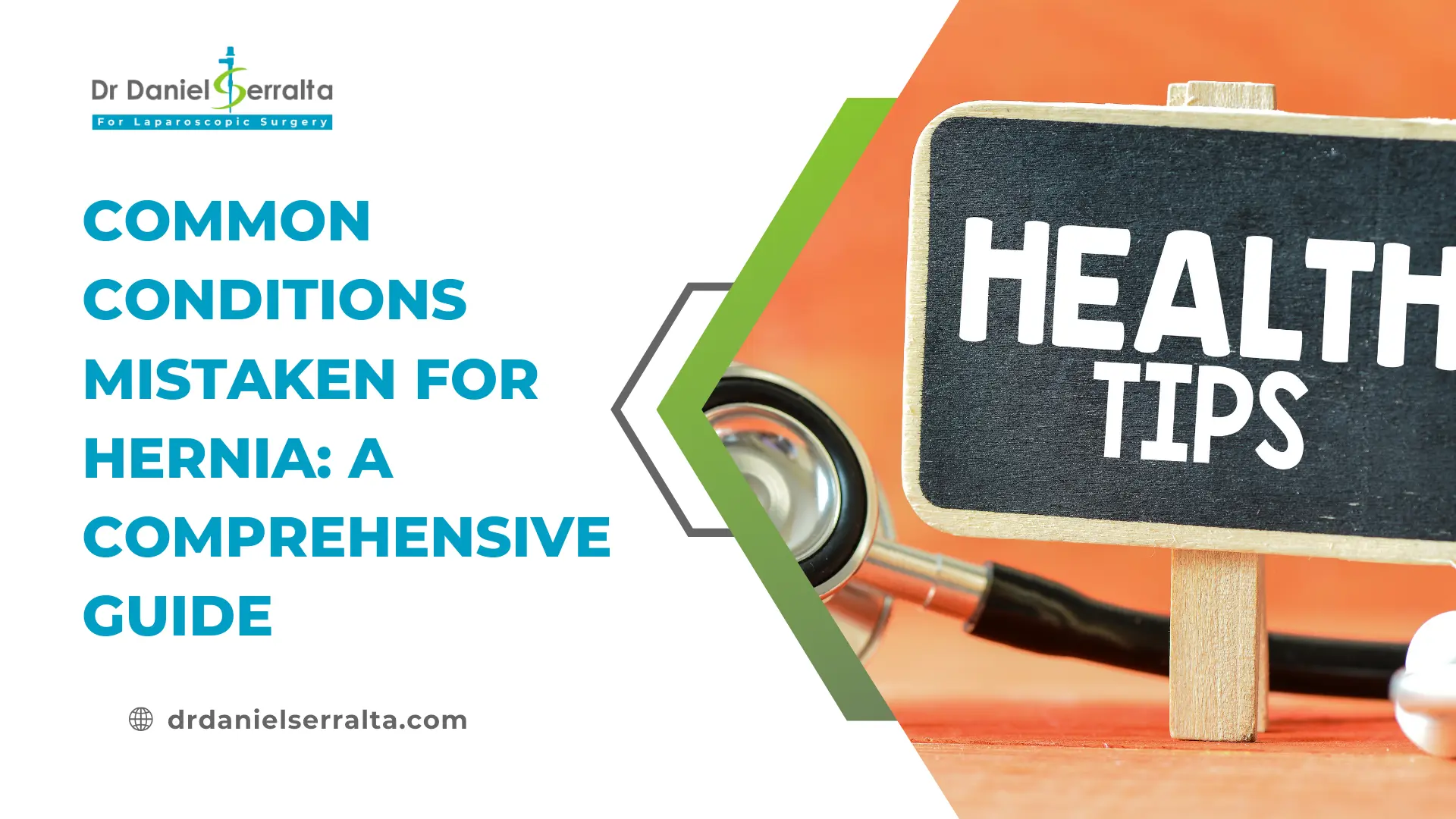Common Conditions Mistaken for Hernia: A Comprehensive Guide

Many patients visit clinics in Dubai concerned about a hernia, only to discover something else entirely. Several conditions mistaken for Hernia present with similar signs—pain, swelling, or a lump in the abdominal or groin region. However, while hernias require specific surgical interventions, some of these other conditions need very different treatments. Understanding the differences is crucial to avoid misdiagnosis and unnecessary anxiety.
Understanding Hernia Basics
A hernia is a condition where an internal organ pushes through a weak spot in the muscle or tissue wall. The most common types include inguinal, femoral, umbilical, and incisional hernias.
Typical symptoms include:
- A visible or palpable bulge, especially when coughing or straining
- Pain or discomfort in the affected area
- A feeling of pressure or heaviness
- A reducible lump that flattens when lying down
However, not every lump or ache is a hernia. Proper examination, often with ultrasound or CT imaging, is essential for confirmation. Patients in Dubai should consult a hernia specialist in Dubai to ensure an accurate diagnosis.
Gastrointestinal Disorders
Some gastrointestinal issues produce symptoms that overlap with hernias. These include:
Irritable Bowel Syndrome (IBS): Bloating, abdominal cramping, and changes in bowel habits can feel like internal pressure. This sensation may mimic a ventral or umbilical hernia.
Gastritis or Peptic Ulcers: These conditions cause upper abdominal discomfort. Patients may feel pain after meals or when the stomach is empty, mistaking it for hernia-related issues.
Constipation or Gas Retention: Chronic constipation can create a visible bulge in the abdomen and feelings of tightness. Although no tissue protrudes, the symptoms may lead patients to assume they have a hernia.
These conditions similar to hernia, often resolve with medical therapy, dietary adjustments, and stress management.
Muscle & Soft-Tissue Injuries
Muscle injuries are among the most commonly mistaken conditions for Hernia. These include:
Abdominal Muscle Strain: Heavy lifting, workouts, or sudden twisting can strain abdominal muscles. The soreness or swelling can resemble a hernia, especially when located near the groin.
Rectus Abdominis Tear: This injury presents as a painful midline bulge. Athletes may report pain during sit-ups or stretching, similar to hernia discomfort.
Groin Muscle Injuries: Pain in the groin area can be from adductor strains or tendinitis. Unlike hernias, these injuries don’t cause a soft, reducible bulge.
While hernias require surgical correction, muscle injuries benefit from rest, physiotherapy, and anti-inflammatory medications.
Lipomas, Lymph Nodes & Masses
Benign lumps in the abdominal or groin area are often conditions mistaken for hernia. These include:
Lipomas: These are soft, fatty tumors found under the skin. They grow slowly, are non-tender, and easily movable. Unlike hernias, they don’t increase with strain.
Enlarged Lymph Nodes: Infections or inflammatory conditions can enlarge lymph nodes in the groin or abdomen. These may feel like tender or rubbery lumps, leading some to believe they have a hernia.
Hematomas or Abscesses: Following trauma or surgery, fluid collection under the skin may mimic a hernia. A physical exam and imaging will clearly distinguish these from true hernias.
Dubai clinics often use high-resolution ultrasound to differentiate these masses quickly and accurately.
Sports Hernia (Athletic Pubalgia)
One of the most commonly confused conditions similar to hernia is the sports hernia. Despite its name, this is not a true hernia.
What is it?
A sports hernia involves a strain or tear in the soft tissues of the lower abdomen or groin. It is common among athletes, especially those in contact sports or activities involving sharp twists and turns.
Symptoms include:
- Chronic groin pain
- Pain during movements like sprinting, kicking, or sit-ups
- No visible or palpable bulge
Unlike traditional hernias, a sports hernia doesn’t involve a tissue protrusion. Diagnosis often involves MRI or dynamic ultrasound. Treatment includes rest, physical therapy, and sometimes surgery, usually performed by the best hernia surgeon in Dubai who specializes in sports injuries.
Other Rare Conditions
A few other conditions may confuse both patients and general physicians:
Diastasis Recti: This is a separation of the rectus abdominis muscles along the midline. It appears as a vertical bulge and is common in postpartum women. While it mimics a hernia visually, it requires core strengthening rather than surgery.
Hydrocele, Varicocele, and Spermatocele: These scrotal conditions often resemble inguinal hernias due to swelling or dragging sensations. However, these affect the testicles and spermatic cord and must be evaluated through scrotal ultrasound.
Obturator or Internal Hernias: These rare hernias occur deep within the pelvis or abdominal cavity. They are not visible externally and are typically diagnosed through imaging when other causes are ruled out.
How to Differentiate—When to See a Doctor
Many conditions mistaken for hernia overlap in symptoms. However, some signs are more specific to actual hernias:
- A bulge that appears with straining or coughing
- Pain that reduces upon lying down
- A soft, compressible lump
- Discomfort during lifting or exercise
If the lump is hard, fixed, painful at rest, or accompanied by fever, other conditions are more likely. In such cases, consult a hernia specialist in Dubai for a proper evaluation. Imaging tests such as ultrasound or CT scans help determine the exact diagnosis and appropriate treatment.
Patients unsure about symptoms should avoid self-diagnosis. Early consultation ensures faster relief and prevents complications.
Conclusion
Hernias are often straightforward to diagnose, but several other conditions can imitate their symptoms. While some require surgery, others improve with medication, physical therapy, or minor interventions. Distinguishing between them is essential to avoid unnecessary procedures or prolonged discomfort.
Dubai offers excellent healthcare access, including clinics with diagnostic imaging and the best hernia surgeon in Dubai. If a hernia is confirmed, patients can explore options for minimally invasive procedures. Additionally, understanding the hernia surgery cost in Dubai and insurance coverage ensures you’re prepared for any necessary treatment. Consulting Dr. Daniel Serralta, the Hernia Specialist in Dubai, ensures you get the right diagnosis and effective care.
FAQs
1. Can gas pain feel like a hernia?
Yes. Bloating and trapped gas can cause abdominal pressure, often confused with a hernia.
2. How do I know if my groin pain is a hernia?
A hernia usually causes a visible bulge and pain that worsens with strain. A specialist can confirm it.
3. Can an ultrasound miss a hernia?
Rarely. Deep or small hernias may be missed. In such cases, CT or MRI may help.
4. Are all lumps in the abdomen hernias?
No. Lumps may be due to lipomas, cysts, or lymph nodes. Imaging distinguishes between these.
5. What is the average hernia surgery cost in Dubai?
Hernia surgery cost in Dubai varies by procedure and hospital. Day surgeries tend to be more affordable.







